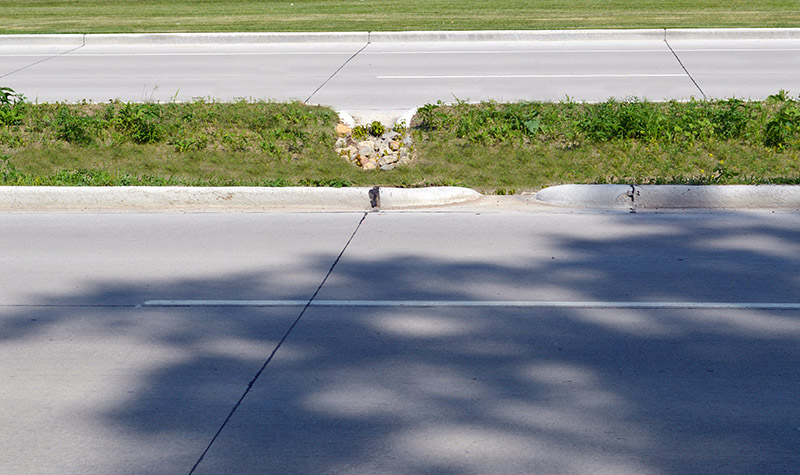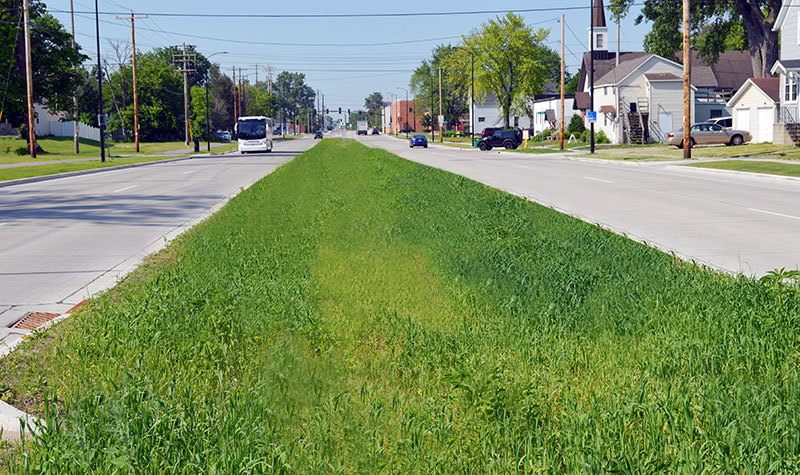Depressed Median Controls Stormwater, Improves Runoff
 By Troy Robillard, PE
By Troy Robillard, PE
The majority of water falling from the sky onto an urban street will get collected by a curb and gutter system and flow directly into a storm sewer. That water then flows into our streams, creeks, and rivers, often carrying pollution and suspended solids that can be harmful to our waterways.
Sometimes opportunities present themselves to rethink how that stormwater is managed when designing a street reconstruction. The use of a depressed median can do wonders for reducing the peak flow quantity and improving the quality of the stormwater runoff.

About the Expert:
Troy Robillard, PE, served as the project manager for the City of Green Bay’s North Webster Avenue project. He manages transportation services in our Green Bay office and works as a project manager to complete transportation design services throughout eastern Wisconsin.
What Is a Depressed Median?
A median that runs down the center of a street acts as a separator for traffic lanes. A depressed median, however, adds the function of a collector for stormwater. The roadway drainage enters the median through curb openings to a flume and then flows to catch basins in the median.
From an environmental standpoint, biofiltration through the depressed median’s grass or other plantings not only helps control the quantity of water draining to adjacent waterways during a rain event but also improves water quality. More total suspended solids (TSS) are removed and total phosphorus (TP) can be controlled through the use of the depressed median, which serves as a bioswale. For a detailed look at how bioswales work, see our previous blog.
A Case Study: North Webster Avenue
The City of Green Bay, Wisconsin, considered stormwater management options during a recent reconstruction of North Webster Avenue, a busy four-lane road that connects Interstate 43 with downtown Green Bay. Green Bay, as part of its state stormwater permitting, is required, to the maximum extent practicable, to implement a reduction in TSS and TP in runoff that enters waters of the state.
 The depressed median was evaluated and selected as the preferred alternative to help with stormwater collection and treatment before entering into the storm sewer system.
The depressed median was evaluated and selected as the preferred alternative to help with stormwater collection and treatment before entering into the storm sewer system.
The project was designed with a redundant stormwater system as well. This double system provides for storm drainage during times when the biofilters are frozen and for high-intensity storm events where the biofilters would be overwhelmed. This depressed median allowed for a reduction of storm sewer inlets that needed to be installed and maintained along the project.
In addition, the grassed median biofilters were designed with plant species that not only provide filtration for TSS removal and TP reduction but also will not require regular mowing. This will reduce the carbon footprint created by this project through fewer lawn mower emissions.
The project won the 2020 Project of the Year Award from the American Public Works Association, Wisconsin Chapter. You can learn more about this project in our latest issue of TRENDS.
Contact any of our roadway design experts to discuss stormwater management alternatives for transportation projects.

Post a comment: